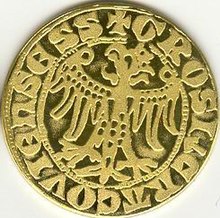

The Kraków grosz ( Latin: grossus cracoviensis (sing.), grossi cracovienses (pl.), Polish: grosz krakowski, German: Krakauer Groschen) were medieval silver coins minted in 14th century Kraków. [1]
Following the Bohemian Prague groschen in use since 1300, and other large silver groschen-type coins issued in the Holy Roman Empire, the coin was introduced in 1367 during the reign of King Casimir III of Poland. [2]
Its obverse and reverse sides had the following text:
- KAZIMIRVS PRIMUS DEI GRATIA REX POLONIE
- GROSI CRACOVIENSESS (sic!)
References
- ^ Davidko, Natalya (2018). "Anglo-Norman Money Names in Context". Kalbų Studijos (32): 94–116. ISSN 1648-2824.
- ^ "Poland - The arrival of the Teutonic Knights | Britannica". www.britannica.com. Retrieved 2022-05-11.


The Kraków grosz ( Latin: grossus cracoviensis (sing.), grossi cracovienses (pl.), Polish: grosz krakowski, German: Krakauer Groschen) were medieval silver coins minted in 14th century Kraków. [1]
Following the Bohemian Prague groschen in use since 1300, and other large silver groschen-type coins issued in the Holy Roman Empire, the coin was introduced in 1367 during the reign of King Casimir III of Poland. [2]
Its obverse and reverse sides had the following text:
- KAZIMIRVS PRIMUS DEI GRATIA REX POLONIE
- GROSI CRACOVIENSESS (sic!)
References
- ^ Davidko, Natalya (2018). "Anglo-Norman Money Names in Context". Kalbų Studijos (32): 94–116. ISSN 1648-2824.
- ^ "Poland - The arrival of the Teutonic Knights | Britannica". www.britannica.com. Retrieved 2022-05-11.
